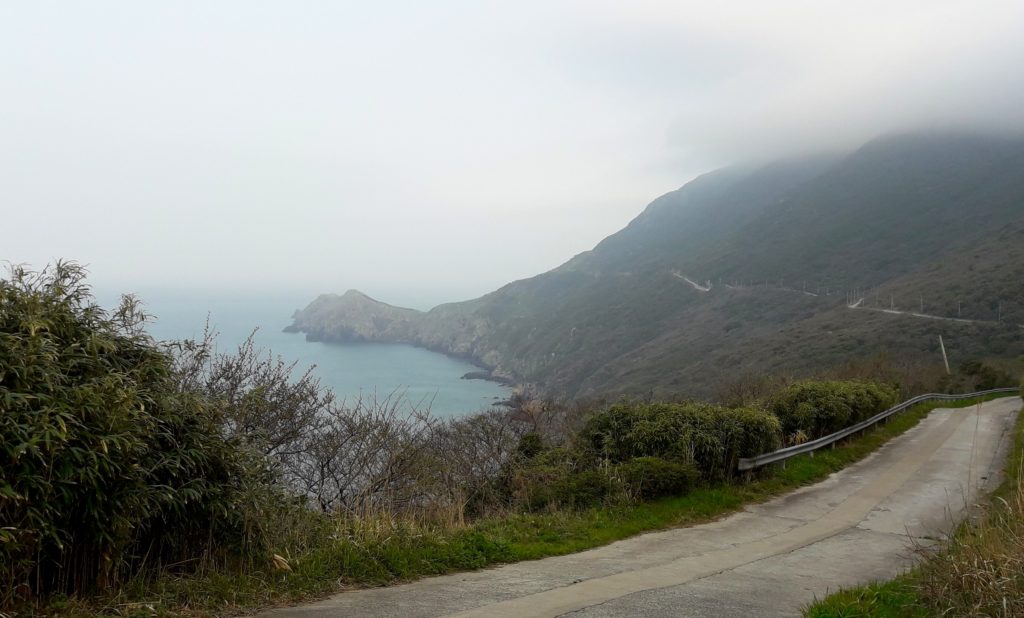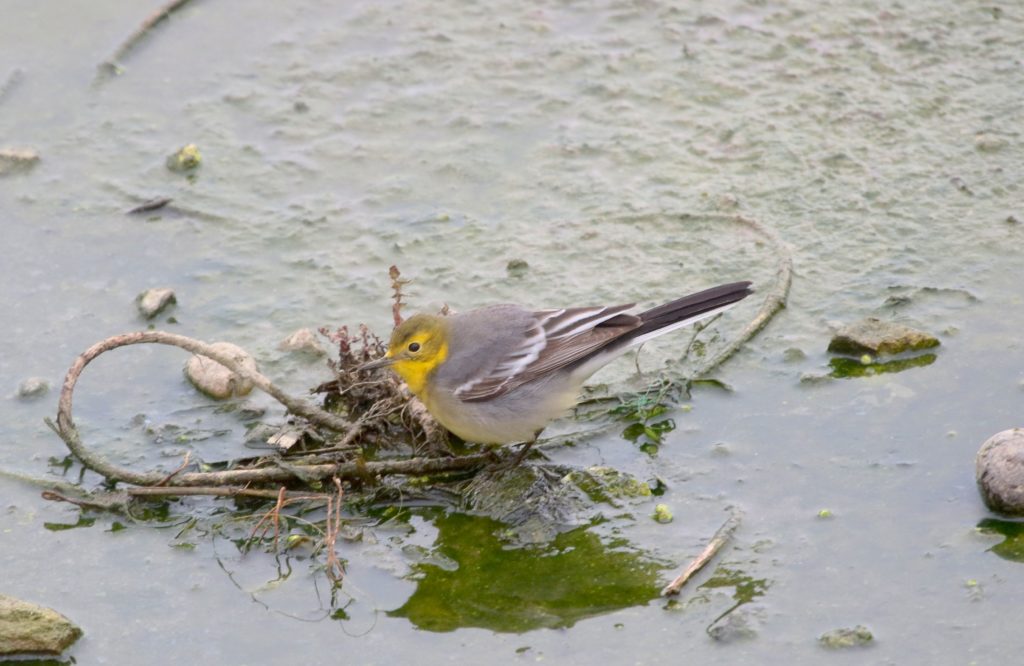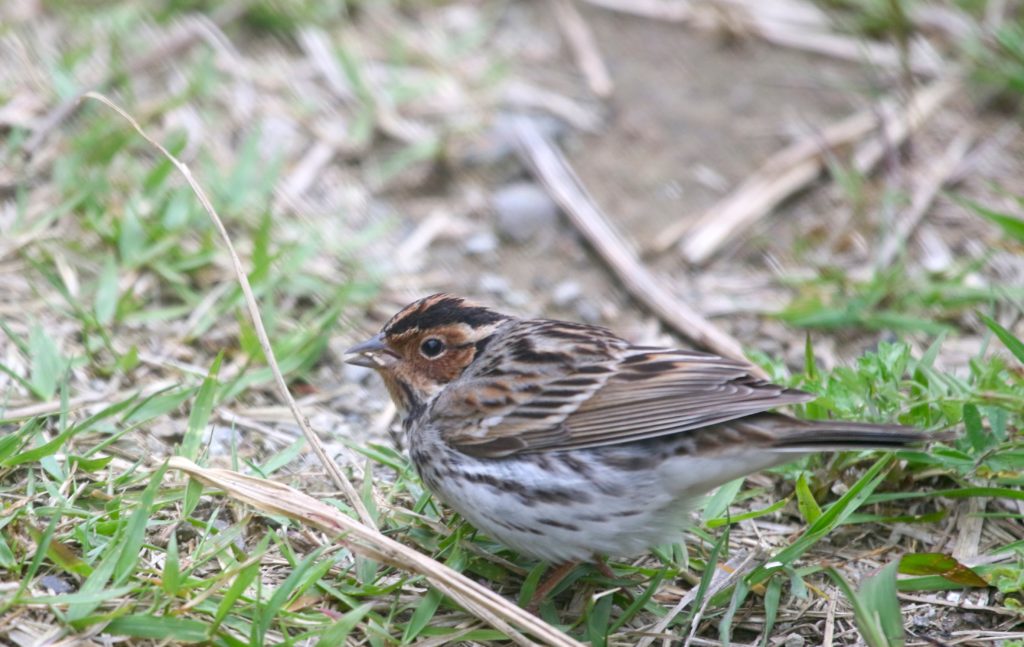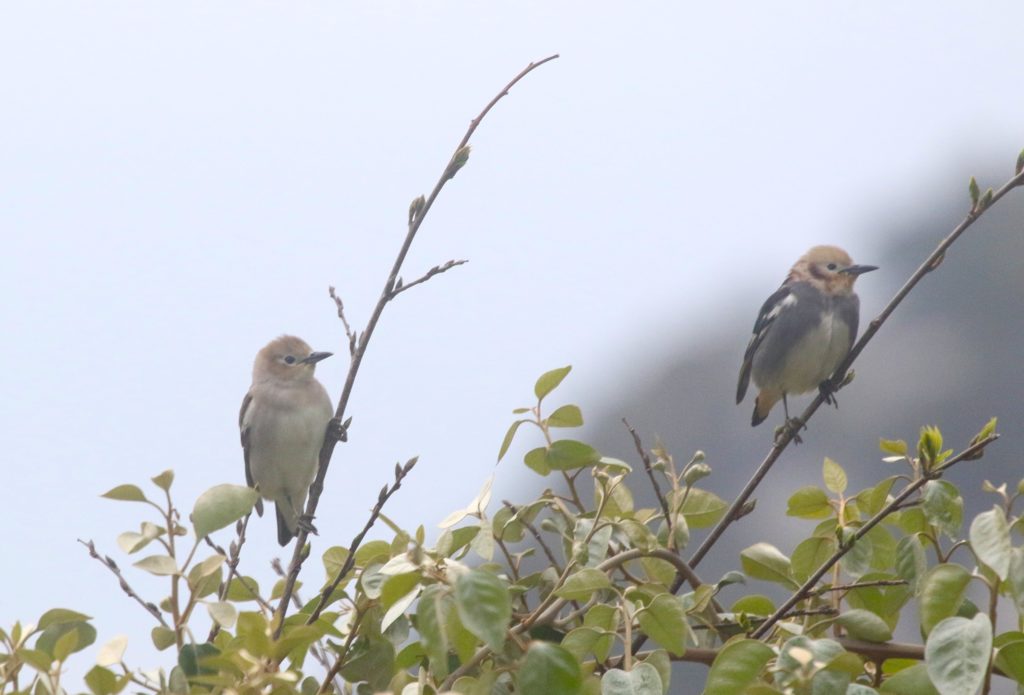
Gageo Island, April 18-May 2, 2019
April 18th
Back on Gageo-do after six years! Not much from the Mokpo-Gageo ferry besides some Ancient Murrelets. While it was amazing to be back on Gageo, there were some negative developments at many of the 1-Gu hotspots familiar to island birders.
The quiet harbour I recall has been replaced by incessant noisy dredging, as well as extensive construction on a massive new concrete jetty. Perhaps to supply this thirst for concrete, the quarry is no longer dormant. It is operating at full tilt, and the topography is much changed there. There is no longer a wide tract of reedy gravel favoured by species such as Oriental Plover, Sharp-tailed Sandpiper, Oriental Pratincole, and Little Whimbrels, among many others.
Most upsetting is the seemingly pointless felling of most of the trees in the area next to the school, as well as some of the top half of the gully. Once a shady, flowered refuge for migrating birds, the area is now a sun-bleached wasteland where locals have started dumping their refuse. I don’t begrudge anyone their progress or infrastructure, but it stings to witness seemingly pointless destruction of habitat. The felled trees have been there for some years, from the looks of them.
The ferry got in at noon, so I did a six hour scan of 1-Gu in the p.m. to figure out what is kicking about town. Overall, less birdy than Chuja so far, but a similar feel to the composition of migrants.
Highlights: one Cattle Egret in the harbour; two Intermediate Egrets near the mossy slab, seemingly having trouble finding a source of food; someone’s tame leg-banded pigeon is hanging out in the harbour; several Goldcrests above the quarry; six Narcissus Flycatchers; three Ochre-rumped Buntings; one Yellow-breasted Bunting; two Daurian Redstarts at the dump.


April 19th
Gageo was socked-in with fog for the entire morning and most of the afternoon, with 54 species logged over eight hours.
Highlights: two Grey-faced Buzzards; four species of pipit (1 Pechora, 4 Red-throated, 26 Olive-backed, 11 Buff-bellied); one or two Chinese Blackbirds in the old gardens; several Brown-headed and Grey-backed among the more numerous Pale and Dusky Thrushes; small numbers of Dusky and Yellow-browed Warblers; at least 15 Narcissus Flycatchers; one Varied Tit; two Common Rosefinch in the fog above the quarry just after dawn; six Red-billed Starlings; and a Large-billed Crow above town.
Seven species of bunting were counted, including single examples of Yellow-breasted and Japanese Yellow Bunting. Unfortunately, the long strip of weeds and flowers in the main town where I spotted both of these decreasingly-common birds was weed-whacked down to the dirt sometime during the day. It would be helpful if such landscaping work was abstained from during the few weeks of migration season, as any source of refuge and food, even one as seemingly insignificant as a 100-metre strip of grass and flowers, can spell the difference between life and death for exhausted birds fresh in. Perhaps the team of government bird banders could help organize such an education initiative? Why not help preserve bird habitat as well as keeping track of numbers…




April 20th
I tested my knees with the long walk up to 2-Gu in the north of the island, a solid two-hour walk (one-way). On the way: a lone Black Wood Pigeon clacking through a gap between trees; four Blue-and-White Flycatchers; upwards of 25 Narcissus Flycatchers (they were everywhere); and a flock of 11 Yellow-bellied Tits foraging through the treetops.
In among the wind-tormented cliffs of 2-Gu proper, a Japanese Quail, a Pacific Swift, an Eastern Yellow Wagtail, a Eurasian Wryneck, two Grey Thrush, two or three Chinese Blackbirds (!), and eight White-cheeked Starlings.



It felt very unbirdy in town on the afternoon of the 20th – the sense of a clearout in 1-Gu was reinforced when the banding team left early with a shrug and a “No birds.”
As I walked along the first path above the quarry, I came across my first Yellow-rumped Flycatcher of the spring, a cracking male. I slowly moved in closer, when a hiker with a trail radio came by and flushed the bird right on cue. After letting the man pass by, I waited for a few minutes for the bird to reappear. It didn’t.
I was grumbling to myself as I continued down the path, and this seemed to flush a chunky, tan-toned bunting from scrub at my feet. Before it landed on the rock nearby, I knew what it was – Black-headed Bunting! This is a rare overshoot to Korea that winters in India – definitely a bird that wasn’t high on the list of birds I was expecting to see this spring! I made sure to get some record shots, and the bird was confiding for about 30 seconds, before it flew straight up the quarry wall.


April 21st
Even with 52 species logged on the day, it felt quite unbirdy. Notable: four Cattle Egrets circled town all day without finding anywhere to settle for long; a Black Wood Pigeon flew over the quarry; a Pechora Pipit on the mossy slab; a personal first Siberian Blue Robin of the spring; an Oriental Reed Warbler that initially confused me with its silence; nine species of bunting, including the Black-headed still, which was spotted higher up in the quarry; a Japanese Grosbeak, and a Chestnut-cheeked Starling with a small flock of Grey-cheeked Starlings.
April 22nd
With the wind coming from the north, nothing new on the bird front today – I’m seeing the same set of birds over and over. An Eastern Buzzard with an injured wing is still in the gully; two Siberian Blue Robins and three Yellow-rumped Flycatchers were in the eastern part of 1-Gu; a Grey Thrush and a Chinese Blackbird continue in the old gardens; the almost-tame Black-headed Bunting is still around in the quarry.
I went for a nosey up into the hills above the quarry. Not much about, but it was interesting to observe the local tribe of Varied Tits.

April 23rd
A rainy day, but still with a species count in the mid-50s. A dawn foray was aborted after 45 minutes of heavy downpour that threatened to defeat the ad-hoc protective gear on my optics. The rain ebbed towards mid-day, allowing for two hurried circuits of 1-Gu.
Most of the birds of note continue, with seemingly little turnover. The winds were blowing out of the southeast for most of the day – still waiting on those southerlies. Tomorrow perhaps?
“New” birds recorded in 1-Gu have most likely been around, but I hadn’t gotten around to seeing them yet. These include: a Japanese Quail above the quarry; a Wood Sandpiper on the mossy slab; several Asian House Martins; a skulky Eyebrowed Thrush; a Pale-legged (Or…Sakhalin?) Leaf Warbler; and a Rustic Bunting – the 11th bunting species I’ve logged on Gageo Island since arriving last week.

April 24th
The winds overnight were pumping up from the south until Jeju, where they took a sharp left hook, sweeping over Gageo from the east. My fingers were crossed as I headed out into Gageo’s harbour in the foggy dawn. By dawn, the winds were coming in from the west. Where are those southerlies? Way more Barn Swallows around today, with several hundred on patrol low over town. Some new arrivals around the mossy slab had me excited for turnover – three Black-winged Stilts, a Common Sandpiper, and a Chinese Pond Heron. Unfortunately, apart from these stronger-flying species, there were no new passerines around 1-Gu.
In the afternoon, a noticeable uptick in Olive-backed Pipit numbers – with at least a hundred in 1-Gu, and several hundred in 3-Gu, in the north of the island. Also near the 3-Gu lighthouse were several Siberian Rubythroats and Siberian Blue Robins. A few more Yellow Buntings around, as well as a Common Kingfisher and another Common Rosefinch were seen in 1-Gu towards dusk.




April 25th
Bored with the same old birds in 1-Gu, I
undertook the long walk to 2-Gu in the morning. It seemed that, in spite of the
winds blowing from precisely the wrong direction, there was a decent arrival of
new birds in the night. The cuckoos are back! After cresting the top of the
steep switchback road out of 1-Gu, I first heard the eerie “Poo-poo poo-poo
poo-poo” of an Oriental Cuckoo, followed shortly after by an Indian
Cuckoo’s “Woop-woop-WOOP-wup.”
At least eight Black Wood Pigeons were
seen or heard on the road to 2-Gu, including one perching on a wire.
Not many birds recorded in Hangri Village
itself, as the fog was so thick that effective visibility was often only at
about 20 feet or so. A Brown-headed Thrush and a Chinese
Blackbird were notable in the old stone-walled gardens, which are
tended by some of the less than dozen or so elderly inhabitants of what is
surely one of the most remote and archaic settlements in South Korea.
On the way back, two more Common
Rosefinch, and the beginning of the surge in the Olive-backed
Pipits (400+) and Black-faced Buntings (at least
850). The latter species were everywhere, especially when I did an afternoon
circuit of 1-Gu – there were several flushing from the trail at all times, from
the quarry all the way up and around “Little Hokkaido” and into the upper
village, with more overhead, and many seen coming in off the sea. A noticeable
arrival of Little Buntings (150+) was mixed in, and several
more Yellow,Tristram’s, Yellow-browed, and Yellow-throated
Buntings kicking around town, as well as single Chestnut and Chestnut-eared
Buntings.
A Common Kingfisher in
the harbour still, and an uptick in Siberian Rubythroat (9)
and Siberian Blue Robin (4) numbers. More White
Wagtails noted too, with nine species of pipits and wagtails for the
day including several Eastern Yellow Wagtails (both tschutschensis,
taivana, and macronyx), a Richard’s Pipit, and a Citrine
Wagtail.
There was a huge influx of hirundines
towards dusk, mostly Red-rumped Swallows, with at least 750, but
possibly twice that number fluttering over town, or perched – I noticed that
every wire in town was heavy with swallows as the skies darkened.
The 68th and final species for the day
was seen well after sunset, when I poked my head out of the bathroom window to
spy on the hundreds of chattering swallows on the wires and came nose to bill
with a Sand Martin, less than a foot away.








April 26th
In
spite of crisp northerly winds, birds were moving to where they need to go,
with noticeable turnover today, and 81 species logged. It was quite fresh at
dawn, with temperatures hovering in the low single digits.
The cold snap unfortunately resulted in
quite a few dead birds, mostly Red-rumped Swallows. I’ve been finding
dead birds every day, as I have in past springs, and it reminded me of the
hugeness of what migration is, and why I want to be here to witness it. These
birds travel massive distances twice a year, running the gauntlet of
innumerable fatal threats, just to push their blood into the future.
Notable at the mossy slab today were
a Striated Heron, a Chinese Pond Heron, two Pacific
Golden Plovers, a Kentish Plover, four Long-toed Stints,
a Curlew Sandpiper, a Common Greenshank, and four Wood
Sandpipers (two of which decided that Gageo was a good place to
copulate). There were two probable Pintail Snipes and a Brown
Shrike (singing a Bluethroat-like remix of mimicry) above
the quarry.
Other highlights included a Northern
House Martin, two female Citrine Wagtails near the dump and a
male on the other side of town, several Richard’s and Blyth’s
Pipits (ten species of pipits and wagtails on the day), two male Taiga
Flycatchers (with differing intensities of throat colouration) on the
west side of 1-Gu, a first Grey-sided Flycatcher of the
spring, and ten species of buntings. Several Oriental Turtle Doves have
been seen every day – I don’t seem to recall seeing them on Gageo on 2013, but
I’ll have to check my notes.
The day ended with some late afternoon
sunshine, which probably saved the lives of some swallows – there were
disorderly, exhausted ranks of hirundines sunning themselves on every available
horizontal surface in town.



April 27th
I was
feeling groggy this morning, so what better way to wake up with an adrenal
spine-shock than almost tripping over a Bluethroat at dawn,
ten feet from the front door of my minbak!
Siberian Blue Robins and Siberian Rubythroats continue
at the edges of town, and another Common Rosefinch was seen at
the top to the gully. There was the feeling of clear-out in the afternoon, and
the lion’s share of the swallows have moved on. Fingers crossed Monday’s
forecast southerly winds change things up a bit here.







April 28th
Dawn was grim, both weather-wise, and
with the body count along the streets and trails of 1-Gu. Another cold night
killed off a lot of migrants, many of which show up on Gageo exhausted, and
with little fat stores. The inclement weather meant there were no flying
insects to feed the birds, nor sun to warm them, which lead to distressing
scenes of dozens of dead and dying birds in some places. I know this is part of
migration, but it hurt my sensitive heart to see birds immobile on the trail,
heads tucked under their wings, surrendering to the elements and waiting to
complete the final journey.
I decided to check out the road to 3-Gu
to see what was up there. At a small forest edge clearing, three doves flushed
across the road – two Oriental Turtle Doves, and a smaller dove that was
notable for the bold, solid colours and ‘geometric’ patterns on its upperparts. Red
Turtle Dove! It split from the other two doves and dropped onto the slope
next to the road. I managed to get a headless record shot of the bird as it
sheltered from the stiff winds and rain, before it dissolved into the
undergrowth.
Also on this steep and winding road were
a Eurasian Wryneck, at least 100 Tristram’s Buntings,
and a personal first Oriental Dollarbird of spring.
There was more shorebird variety around
the mossy slab, including a Whimbrel that was wandering around the
parking lot to the new and improved quarry, taking shelter under a truck at one
point. The day’s total was 84 species, my highest tally of spring so far.
Tomorrow could be interesting, with rain and wind supposedly coming out of the
south.

with White-cheeked Starling Spodiopsar cineraceus


April 29th
More cold and wet weather overnight, so
more dead birds littering Gageo-do. Unfortunately, one of the Taiga
Flycatchers was found dead near the power plant, having succumbed to
the cold and resultant lack of available insects. I saw it in the same area
yesterday, lethargically searching for food. Many of the birds I saw along the
trails today seemed similarly punch-drunk and not as wary as they need to be.
With the rains and south-easterly winds,
there was a clear-out of many of the birds that have been stuck in town for the
past week, without much in the way of arrivals. The three new species noted
around 1-Gu in the morning were two Little Whimbrels, a Rufous-tailed
Robin, and a White-cheeked Starling. The Little
Whimbrels, like their ‘full-sized’ cousin yesterday, were wandering around
in the parking lot for the new quarry, perhaps wondering what had happened to
the weedy gravel field they favoured in the old configuration of the quarry.
The heavy rains began in earnest at about
10 a.m., forcing me to retreat inside for the day. I managed to get out briefly
in the late afternoon for a quick rain recon, and found some new shorebirds at
the mossy slab – four Terek Sandpipers, six Grey-tailed
Tattlers, and aMongolian Plover.


with a grub it dug out of the dirt above the mossy slab


April 30th
Still cold and blustery in the early morning, but by late morning the sun finally returned. With the sun came the insects, and a redoubling of avian activity –wagtails cavorting with grasshoppers, buntings dogfighting with moths, and flycatchers…flycatching. I’ve noticed that Stejneger’s Stonechats are adept at finding caterpillars, which sustained them even during the cold snap – I haven’t seen any dead stonechats yet.
I logged 88 species over eight hours, with seven new species noted: a breeding-plumaged Little Grebe in the harbour, a probable Ruddy-breasted Crake (quick views in a ditch near the dump, all clues point to this species), two Black-tailed Godwits at the mossy slab and another in 2-Gu, two Oriental Scops Owls calling from the hills on the way to 2-Gu, two quick looks at a lark that was possibly a Greater Short-toed Lark, a Mugimaki Flycatcher (love that name) near the power plant, and two Grey-capped Greenfinch at the pass.
Nothing crazy in 2-Gu, besides an interesting variety of turdus thrushes, and loads of the most predominant migrants seen throughout my sojourn on Gageo – Olive-backed Pipits and Black-faced Buntings.
Other interesting sights included four Striated Herons, at least four restless Chinese Pond Herons on the road up to the pass, three Japanese Quail in 2-Gu, a Little Whimbrel still around the dump, and an Oriental Dollarbird on the road to 2-Gu.




May 1st
Hot and hazy, and more of the same, bird-wise. ‘Only’ 84 species, with just two new species today – a Common Moorhen in the quarry, and a Great Crested Grebe in the waters off the quarry. Also in the quarry, I found the ‘other’ Taiga Flycatcher, the one with the less vibrant throat, also dead. It had, in bird-banding terms, ‘zero fat.’ That cold snap was brutal. The Common Greenshank that haunted the mossy slab was also found dead today. It was at the base of the main road up the hill, flattened by a vehicle.
There were noticeably more turdus thrushes above the quarry, with five species recorded, most notably a dozen new Eyebrowed Thrush. More Oriental Reed Warblers have also been noted around town, and they’re finally vocalizing. The past two days have also seen an apparent bump in the numbers of both Blue-and-white Flycatchers and Common Rosefinches. The lone Large-billed Crow still loiters around the dump. Towards the end of my birding day, I puzzled over a flycatcher with a green back and yellowy underparts up on the forested slopes…probably just a female Narcissus?
In the old gardens, a hepatic cuckoo flew into a tree, and I’m guessing it’s the Oriental Cuckoo I’ve been hearing in that area for the past several days. A ‘dark’ cuckoo (?) flew by earlier in the day, making a most peculiar eight-note flight call.
May 2nd
May 2nd was last morning on Gageo, and was the first birding session there without recording a new species…so I left.
For most of my two weeks on Gageo, the winds stubbornly blew out of the north – so no big fall of Verditer Flycatchers or the like. Can’t complain though, it was supremely rewarding to be witness to a small slice of the dynamic force of nature that is spring migration on the East Asian-Australasian Flyway.
Through my two-week sojourn, Gageo played host to loads of titillating species one can only reasonably expect to see on Yellow Sea islands on migration (133 species total). The island also held a few surprises, and decent turnover most days. There were highs, and most definitely some lows. I will remember the cold snap and resultant die-off long after I want to forget it – those were a heavy few days.
I ran into Martin Sutherland and Kim Sona at the docks, and we exchanged notes before I boarded the ferry to Mokpo. In a humorous moment, just after I boarded one of the guys on the boat confused me for Martin (two scruffy guys with green caps and binos…), and insisted I get off, as we had arrived on Gageo! His excellent report detailing Gageo’s bird activity for the week after my stay can be read here: https://www.birdskoreablog.org/?p=22097







